It’s no secret that conserving water is important, especially when it comes to our RV toilets. What is the average amount of water an RV toilet uses per flush? Depending on the model and make of your RV, it could use anywhere from 1.6 gallons to 5 gallons per flush. That’s a lot of water! In this article, we’ll answer some common questions about how much water an RV toilet uses per flush exactly, as well as provide some tips on how to conserve water while you’re on the road.
Table of Contents
What Is a RV Water System?
An RV water system is a combination of all the different appliances, fixtures, and tanks that hold and distribute fresh water to your rig. It includes everything from the water pump to the faucets, showers, and toilets. In short, it’s everything that has to do with bringing clean water into your camper and getting rid of dirty water.
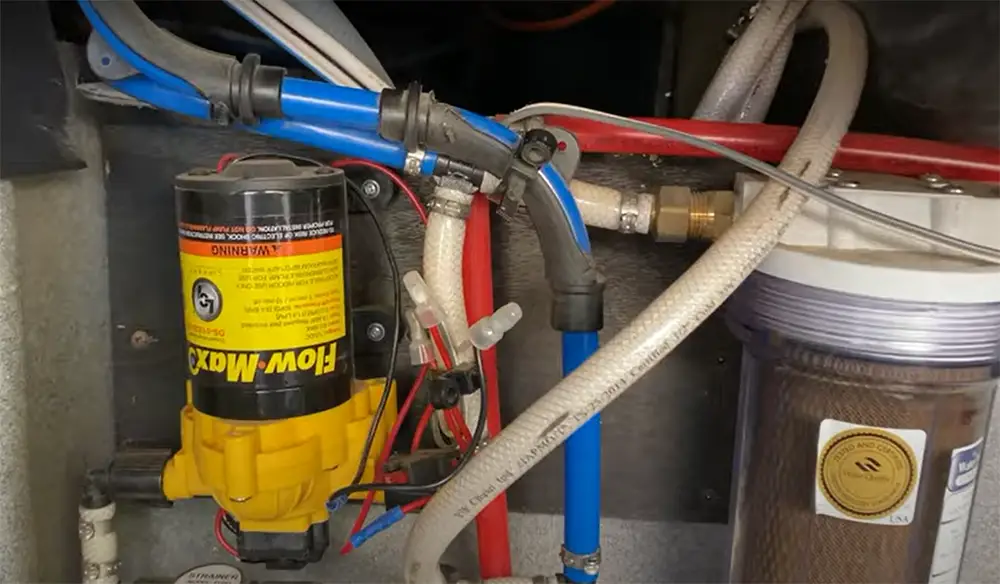
The same is true for the wastewater. When you flush the toilet or drain the sink, the wastewater goes into a holding tank. Once that tank is full, it needs to be emptied at an RV dump station. [1]
Now that you know all that, let’s get back to the question at hand: How much water does an RV toilet use per flush?
To answer your question accurately, we will first need to discuss what toilets are usually used in RV and how to use them properly.
Why Is It Important to Know the Water Usage of Your RV Toilet?
There are a few reasons why it’s important to know how much water exactly your RV toilet uses each time you flush it. The first reason is that it can help you conserve water, which is always a good thing. If you know that your toilet uses a certain amount of water per flush, you can be more conscious of how often you’re flushing and try to limit it to when absolutely necessary. Or you may want to simply know how much you should fill the tank prior to the big trip due.
The second reason is that it can help you budget for your water usage. If you know approximately how much water your toilet uses, you can better estimate your monthly or yearly costs associated with running the toilet. This information can be helpful in deciding whether or not an RV is the right choice for you long-term.
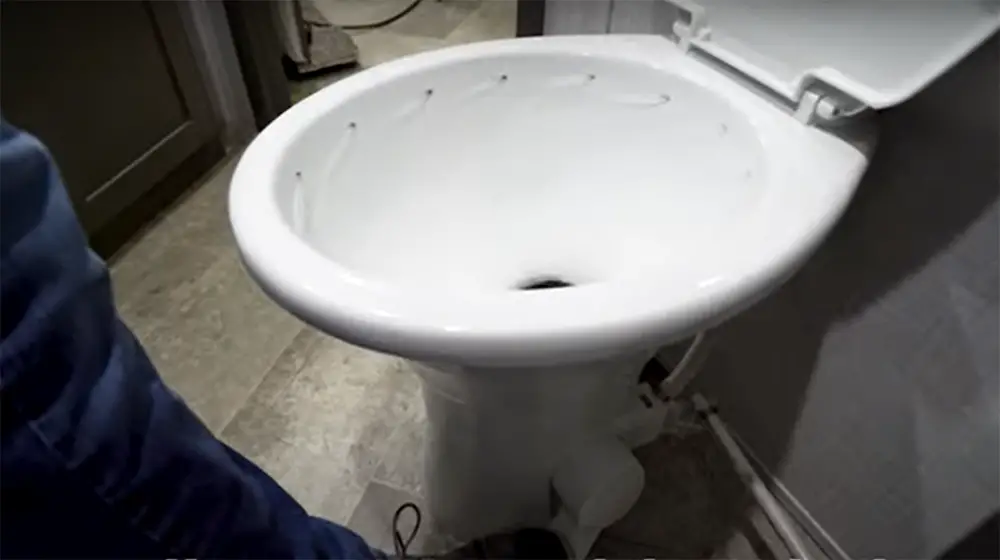
Finally, it’s simply good to know for general purposes. If you’re trying to diagnose a toilet problem or figure out how much water your RV can store in its fresh water tank, knowing the fundamentals about your toilet’s flush capacity is quite helpful.
So now that we’ve gone over why it’s important to know about your RV toilet’s water usage, let’s get into the nitty-gritty and find out exactly how much water they use.
Do All RV Toilets Use Water?
The only exception to the rule is a composting toilet, which doesn’t need water at all. Composting toilets are quite popular in RVs, but they’re not nearly as utilized as traditional RV toilets.
If you’re not familiar with composting toilets, they work by breaking down human waste into a compost-like material. They don’t require any water to operate, which makes them a great choice for boondocking or dry camping. Instead they use a small amount of either moss or wood shavings to help with the breakdown process.
The big downside of these toilets is that they can be a bit more expensive than traditional RV toilets. They also require more maintenance as you will often need to deal with a bad smell coming from it.
Another downside is that they can’t be used as often as traditional toilets. If you have a large family or plan on having a lot of people over, a composting toilet might not be the best choice.
But if you’re looking for a more environmentally-friendly option, or just want to save some water, a composting toilet might be right for you.
There are many more types of RV toilets and their water spendings can differ a lot. Let’s take a look at them. [1], [2], [3]
Types of RV Toilets
There are two main types of toilets that are used in RVs:
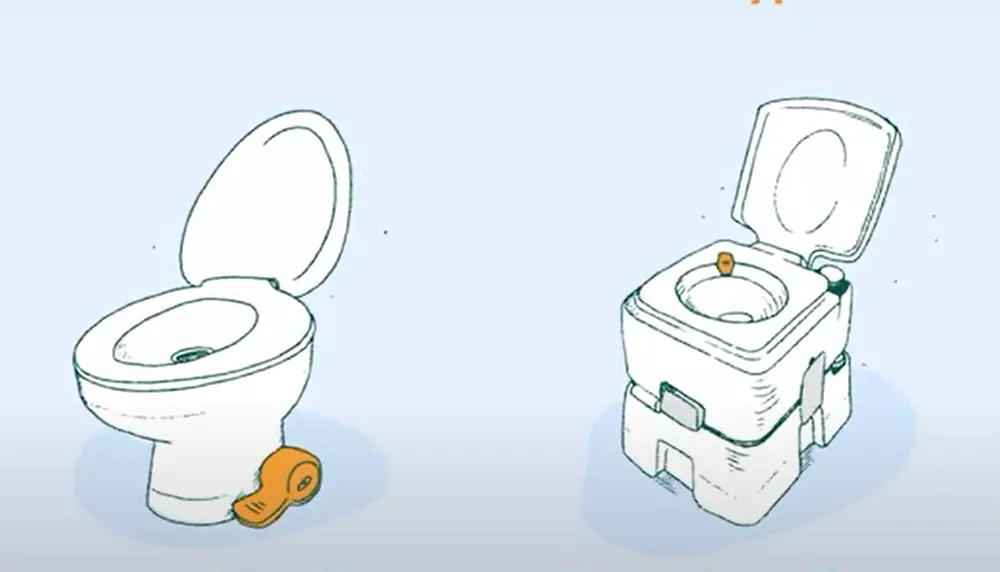
- Gravity flush toilets
- Portable toilets
Gravity flush toilet
One of the common types of RV toilets is the gravity flush. This uses a small amount of water to send waste down into the holding tank and then you can flush it all out with one big push! RV gravity flush toilets work the same way as a regular home toilet, except that it uses less water and doesn’t come with a tank. Instead, it comes with a fresh water tank to store water and a small holding tank for holding waste. This tank is usually located under the RV, although its location may vary.
Gravity flush toilets are operated by a simple pedal or lever. When you press the pedal or lever, a tiny amount of water is released into the toilet bowl. This water then flushes the waste down into the holding tank.
One of the benefits of a gravity flush toilet is that it doesn’t require any electricity to operate. This means that you can use it even if there is no power available. Another benefit is that they are typically very easy to use and maintain.
The main disadvantage of gravity flush toilets is that they can be difficult to empty when the holding tank gets full. This is because the waste has to be flushed down into the tank, which needs to be emptied at a proper waste station. Additionally, these toilets can be noisy when flushing and may require more water than other RV toilet options.
Portable toilets
A portable toilet is another common option you can see being used in the RV. Portable toilets are typically created from plastic and have a tank that needs to be emptied regularly.
When it comes to setting these up, it gets tricky because you will need to ensure that the toilet is securely attached to the floor by a special kit.
Using this toilet is easy, add water to the fresh water tank and pull out a special valve, when done simply push the valve back in.
Portable toilets are great for RVs that do not have a lot of space because they can be stored away when not in use. They are also relatively inexpensive, making them a great option for budget-conscious RVers. Plus a detachable holding tank makes them easy to empty and clean.
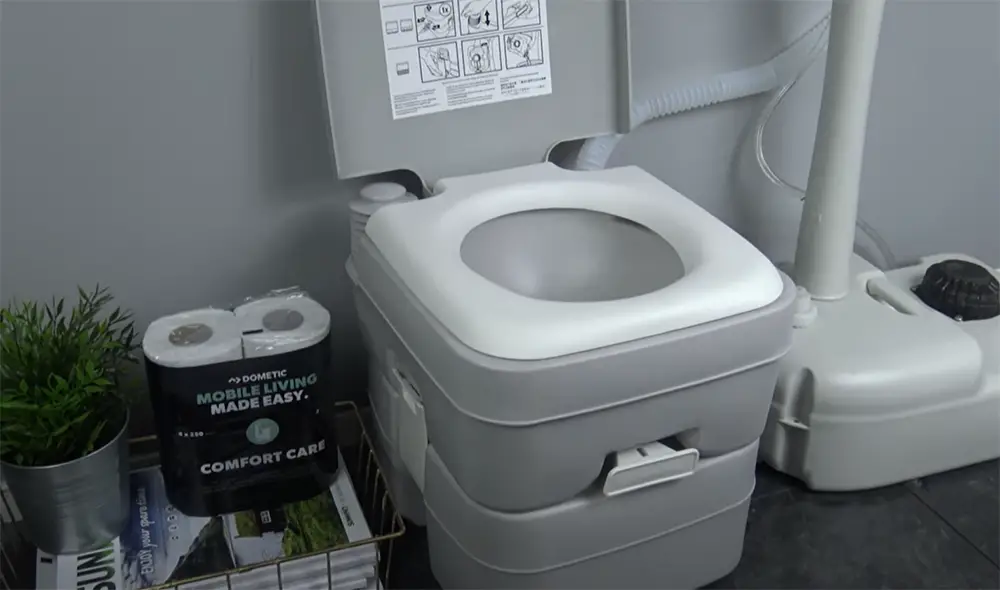
The biggest downside of portable toilets is that they can be very smelly, especially if they are not emptied often enough. Another thing to keep in mind is that portable toilets require chemicals in order to work properly. And it is recommended to add these chemicals to the holding tank on a regular basis in order to prevent bad odors and sewage build-up. [1], [2], [3]
How Much Water Is Used by a RV Toilet Per Flush?
Now that we know the different types of RV toilets, let’s answer the main question of this article and find out how much water they need for flushing.
It’s vital to remember that the amount of water consumed by an RV toilet also depends on how often it is used. For example, if you have a family of four and use your RV toilet several times each day, you will use considerably more water than someone who only uses their RV toilet once daily.
As you can see, there’s not really a single answer to the question. It all depends on the type of toilet and how often it is used. But generally speaking with most types if these toilets expect about 1/2 gallon per flush – which means that they’ll be using less than half as much water overall when compared against traditional plumbing fixtures at home or elsewhere around town. [3], [4], [5]
How to Save the Water When Flushing an RV Toilet
Even though you may think that a RV toilet doesn’t use much water, it’s important to conserve as much of the limited resource we have available. Here are some tips on how to save water on your trips.
How to Save the Water When Flushing an RV Toilet
Even though RV toilets don’t use a lot of water per flush, it’s still important to conserve water as much as possible. Here are a few tips on how to save water when flushing your RV toilet.
Don’t press on the flush pedal for too long
To save water, only press the flush pedal until the indicator shows that the appropriate amount of water has been released. For liquid waste, this is usually just a few seconds. For solid waste, it may take at least 10 seconds.
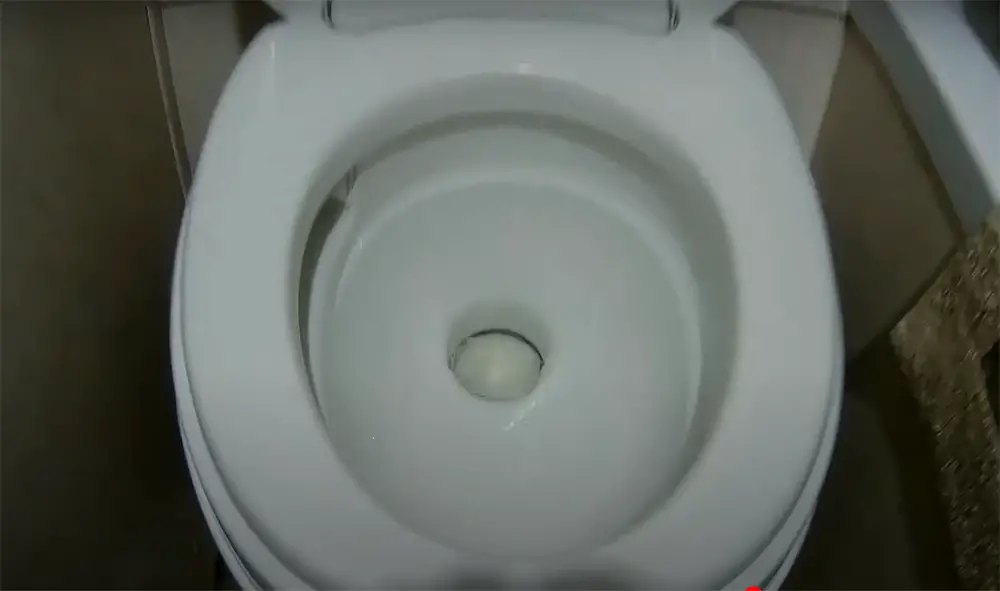
If your RV toilet does not have a dual-flush system, you may still reduce water usage by following the same guidelines and only flushing when absolutely necessary. For example, if there’s just urine in the bowl, you may not need to flush.
If you’re looking to conserve water, there are some models that allow you to adjust the amount of water used per flush. That way, you can find the perfect balance between efficiency and getting rid of all the waste.
Don’t overfill the tank with more water than necessary
When planning your trip, take into account how often you’ll need to empty the waste tank. If you’re only going to be gone for a few days, you don’t need to fill the tank all the way. This will save you water in the long run. You don’t want the water to go to waste if you don’t need it.
When deciding how much water to put in the RV toilet, it is important that you consider not only your own needs but also those of any other users. Consideration should be given towards length and number when selecting an amount for flushing or drinking purposes. Keep in mind these factors upon your decision. And if you know you may pass across a place where you can refill the tank, then you might not need to fill your tank with too much water when departing.
Use gray or shower water for flushing
If you’re boondocking or dry camping, you can use gray water from your shower or sink to flush your toilet. This will save a lot of fresh water.
To do this, you’ll need to set up a gray water tank and have a way to transport the water from the tank to the toilet. You can either use a hose or fill up a bucket and pour it into the toilet bowl. If using gray water, be sure not to flush any solids down the toilet as this will contaminate your gray water tank.
Use public toilets whenever possible
Whenever you’re near a public restroom, take advantage of it. This will save water and also help to extend the time between emptying your black water tank. Of course, this isn’t always possible, but if you’re able to use a public toilet every now and then, it can really make a difference. [5], [6]
FAQ
How long should you flush an RV toilet?
It is recommended that you flush your RV toilet for at least 10 seconds to ensure all waste is removed from the bowl. If you have a black tank, it is also important to add enough water to cover the solid waste in order to break it down properly.
Can you flush toilet paper in a RV toilet?
Yes! All the RV toilets we’ve seen can handle normal toilet paper. However, you might want to avoid flushing things like paper towels, feminine hygiene products, or anything else that’s not designed to break down in water.
How much water does a RV toilet flush use?
The average RV toilet uses less than a gallon of water per flush. However, this can vary depending on the model and brand of your RV toilet. Some models may use as little as a half-gallon of water per flush, while others use even less than that.
Toilets are one of the biggest consumers of water in an RV. If you’re trying to conserve water while dry camping or boondocking, it’s important to know how much water your toilet uses per flush to ensure your trip will be comfortable.
What are some tips and tricks to conserve water while using an RV toilet?
Here are some tips to help you conserve water while using an RV toilet:
- Use a little less water each time you flush. You can do this by holding the handle down for a shorter amount of time.
- Don’t let the water run while you’re brushing your teeth or washing your hands. Turn it off until you’re ready to rinse.
- Collect gray water in a container and use it to flush the toilet next time. Gray water is waste water from sinks, showers, and laundry machines.
- If possible, hook up your RV to a hose with fresh water instead of using the tank water. This will help prevent having to empty and clean the tank as often.
- Use biodegradable RV toilet chemicals. These will break down waste and help to conserve water.
- Have a look at the seals and gaskets on your toilet. If they’re worn, they could be causing leaks. Replacing them can help you save water.
What should I do if my RV toilet starts overflowing?
If your RV toilet starts overflowing, the first thing you should do is turn off the water. Then, check to see if there is anything blocking the drain. If there is, remove it and try flushing again. If the toilet still won’t flush, you may need to call a plumber. In the meantime, you can use a bucket to bail out any water that has collected in the bowl.
Why is it important to conserve water when using an RV toilet?
There are a few reasons why it’s important to conserve water when using an RV toilet:
- RV toilets typically have a small holding tank, so every flush counts.
- You may be boondocking (camping without hookups) which means you’ll need to be extra careful with your water usage.
- Conserving water is just good for the environment!
Which types of RV toilets use the least amount of water?
There are a few types of RV toilets that use less water:
- Composting toilets
- Portable toilets
- Cassette toilets
If you’re looking to conserve water, one of these options may be right for you. Do some research to see which type would be the best fit for your needs.
Can you install a low-flow toilet in an RV?
Yes, you can install a low-flow toilet in an RV. This is a great way to conserve water if you have the proper hookups. You’ll need to make sure that your RV can accommodate a low-flow toilet before you have one installed.
How do you deal with sewage tanks in an RV?
RV sewage tanks typically need to be emptied every few days. You can do this by hooking up your RV to a sewer connection at a campground or dumping station. If you’re boondocking, you’ll need to take your tanks to a dump station. Be sure to follow the proper procedures for emptying and cleaning your tanks.
Can I put bleach in my RV toilet?
Yes, you can put bleach in your RV toilet.
Can you use Pine Sol in an RV toilet?
Yes, you can use Pine Sol in an RV toilet.
Can you use a regular toilet bowl cleaner in an RV toilet?
No, you should not use a regular toilet bowl cleaner in an RV toilet. These cleaners are typically too harsh and can damage the seals or gaskets. Instead, opt for a cleaner specifically designed for RV toilets.
Why do some people think that RV toilets use too much water?
Some people think that RV toilets use too much water because they have a small holding tank. This means that every flush counts. If you’re not careful, you can quickly fill up the tank.
Other people believe that RV toilets are wasteful because they use fresh water to flush. They argue that this water could be used for other purposes, like drinking or cooking.
Useful Video: TEACH ME RV! | Proper RV toilet operation
Conclusion
Planning your water usage is key when traveling in an RV. Although many people think that having an RV toilet means you don’t have to worry about conserving water, this isn’t the case. In fact, most RVs have a self-contained water system which means you need to be especially mindful of how much water you are using. Thankfully, RV toilets typically use less than 0.5 gallons of water per flush – but it does depend on the type of toilet you have installed. So, if you’re wondering just how much water an RV toilet uses , now you have a slight idea! Be sure to plan ahead and conserve where possible to avoid any unpleasant surprises down the road.
References:
- https://rvwhisperer.com/how-much-water-does-an-rv-toilet-use-per-flush/
- https://www.thedrive.com/reviews/28306/best-rv-toilet
- https://toilethaven.com/2020/09/17/types-of-rv-toilets/
- https://drivinvibin.com/2022/01/18/water-per-rv-toilet-flush/
- https://www.thervgeeks.com/how-much-water-does-an-rv-toilet-use-per-flush/
- https://uniquecampingmarine.com/blogs/news/why-using-lots-of-water-in-your-rv-toilet-and-holding-tanks-is-crucial

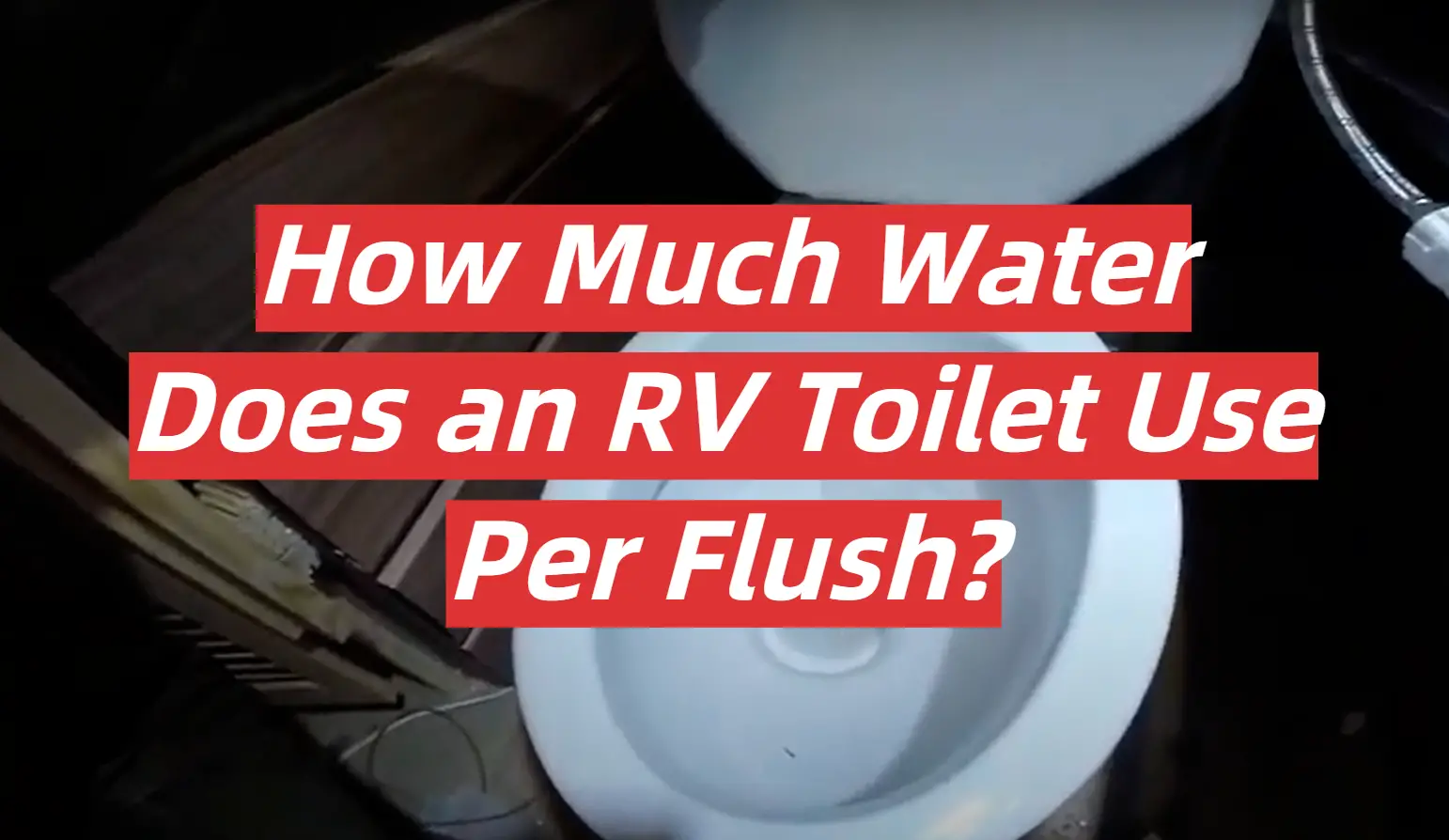




Leave a Reply